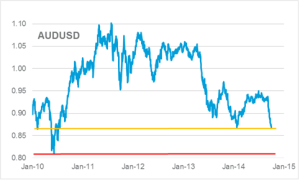Brief Summary:
- This morning, the Australian Bureau of Statistics released retail sales data for August. The figure fell shy of the market expected 0.4 to be 0.1%. The AUD was nudged toward its January 2014 low (more below) as the jittery market took any reason to continue the sell-off. Australian building approvals and trade data will be released tomorrow.
- The NZD dollar fell sharply against the USD as it was revealed that the Reserve Bank of New Zealand intervened in currency markets in August, selling NZD 521 million. It was the biggest such intervention since July 2007. The confirmation of intervention came just days after the RBNZ released a lengthy report why the NZD’s level is unsustainable and unjustified.
Painful memories
Since the beginning of September, the AUD has fallen faster and further than the great ‘taper tantrum’ of 2013; the nickname given to the market moves in anticipation of the tapering of U.S. quantitative easing. AUDUSD has thus far bottomed out this week at its January 2014 low.
The orange line, shown above, is the January low of 0.8660 when the market became uneasy about the timing of the first interest rate rise. As this was slowly revealed and priced in to be at the start of 2015, the market calmed and the AUD held steady for much of 2014.
Below the orange line, the next low point was reached in May 2010 where the AUD made landfall at 0.8067; the red line. Pundits reckon, if the AUD breaks through the orange line, it will not see any meaningful support until the red one.
Referring to the chart above, there are a few key levels that have shown themselves over the course of post-GFC U.S. Fed policy. During quantitative easing 1.05 seemed a fair level for AUDUSD. Post-QE, that level readjusted to about 0.9400. Now, a third readjustment is occurring as the possibility of ‘normal’ interest rates becomes a sooner possibility. Each readjustment resulted in a new low being set followed by a reversal once the rumours became fact.
If history repeats itself, the orange line is likely to be broken in the coming days, however, it is also likely to reverse after, although not all the way. In short, things will probably get worse before they get better.
By Chris Chandler



